|
The Sportiva Latina concept car, developed by Centro Ricerche Fiat
(CRF), was unveiled in May 2005 at the Barcelona International Motor Show, where it was awarded the STA Prize in the fifth edition of the ‘Innovative Concepts for Future Vehicles’ contest. The competition was organised by the Barcelona Fair and the STA
(Sociedad de Técnicos de Automociòn), Spain’s automotive technical association. The prize was awarded to CRF for the best automotive technology content.
The Sportiva Latina received a significant amount of interest from the international press, the innovative concept presenting Fiat’s vision on the future and communicating their new technological solutions. The prototype is in effect the synthesis of various innovations, showcasing in particular:
• Multi-material chassis, developed for a high-performance sports car around the concept of ‘split frame’ architecture, a chassis of elevated structural efficiency separated from the passenger cell by elastic damping mounts in order to improve driving comfort and production flexibility of the product.
• ‘Occhiocentro’ (eye centre), an automatic system which regulates the steering wheel, driver seat and pedals based on the height of the driver’s line of vision, which strives to provide the driver with the correct ergonomic driving position and the best visibility (the most detailed overview of the road) independently to individual anthropometric characteristics (developed by Dr. Riccardo
Seccardini).
• Steer-by-wire, a steering system activated by electrical impulses instead of the traditional mechanical setup which, combined with active suspension, permits the personalisation of the car’s dynamic characteristics and therefore improving safety and driving pleasure.
The following report covers a detailed overview of the concept’s innovations, together with its fascinating design story. It was an extraordinary feat, not only due to the concept’s technological package, but also because of the development time which, from the first sketches to the finished prototype, took only 40 days. This was made possible due to the collaboration of
Mazel, a highly experienced Spanish engineering and design company with many years in the automotive and aeronautical fields.
|
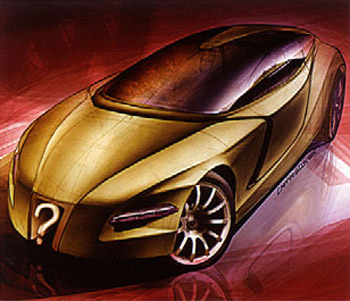
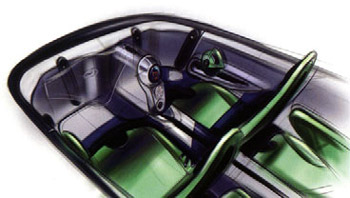
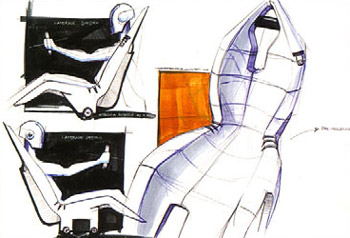
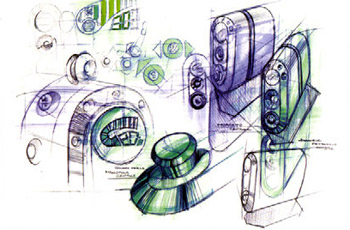 |
|
Top:
The question mark on the front carries the independent project message.
Above: Students Fabio Ferrante and Daniele Petruccio
were responsible for seats and controls. |
|
 |
|
|
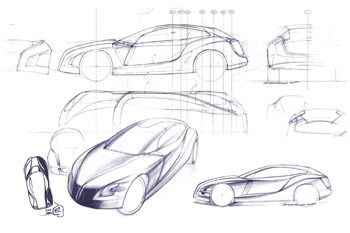
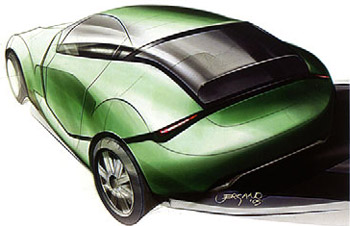
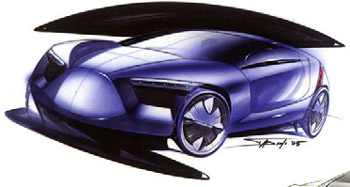 |
|
Initial
sketches were penned by Pietro Camardella. The cab clearly reflects the idea of an
equipped "tank", independent of the chassis, of "split-frame" type. |
|
 |
|
|
Dressing technology: the definition of the Sportiva Latina concept
When, in the second half of March 2005, CRF decided to pick the opportunity to participate in the STA Prize, the engineers asked themselves what they could deliver in just 40 days. The project therefore started off with engineer Enrico Pisano guiding the technological decision-making. The design team was headed by Pietro
Camardella, director of Design Research Centre and CRF, along with Paolo Tadini and Raffaele
Vergano.
The technological content of the car had a
strong sporting formula input, but it was the competition between the Italian and Spanish which immediately suggested and resulted in the ‘Sportiva Latina’ name. After one week of conceptualising and debating ideas, the final project direction was decided upon which focused around showcasing CRF’s multi-material split-frame chassis technology which had previously been developed by the CRF engineering
team.
After the first try-outs on the split-frame theme, the designers decided to focus on a clear-cut solution in order to avoid their message being badly interpreted: it did not have to be the most beautiful styling proposal, but rather an authentic object of design, where form is a direct consequence of function. As the concept was a demonstration of new technologies destined for use in future production cars within the Fiat Group, CRF decided to use no brand markings which also gave the design team more creative freedom.
Obviously, it was intense work to find the solutions which harmonised the division between the chassis and bodywork, making an aesthetically strong and characteristic motive to emphasise the technology rather than conceal it. Camardella was responsible for the exterior and interior design, however the contribution of young student designers running internships at the design centre were extremely useful in the definition of the
seats.
Eventually, the interior, incorporating a luggage compartment, became a small, boat-like cell which was inserted over the complete chassis, engine and drivetrain aggregate. Aesthetically the interior cell took on the form of a comet-shaped pod fitted into the chassis, and the designers left off from there to develop the rest. The separate interior capsule became a strong characterisation of the concept, visible even when the car is complete and therefore communicating the split frame technology. The choice of composite levels was determined by an articulation of exceptionally complex three-dimensional volumes which characterises the design without useless two-dimensional graphics, decorations and added ornaments, typical of modern-day stylistic language.
The elements required for lighting and the data transmission interface (LEDs,
sensors, radar) have been grouped in a unique ring-like
belt that encircles the car body, reconnecting to the
split frame philosophy. This belt is conceived as an
independent three-dimensional body, which at times
becomes detached from the continuity of the main body
shape in order to showcase the minimal LED lighting
technology. |
|
|
|
![]()
![]()